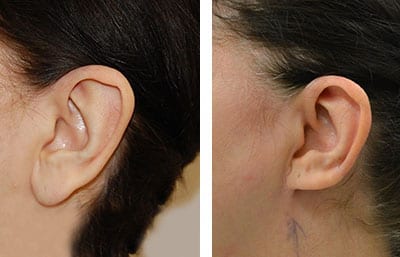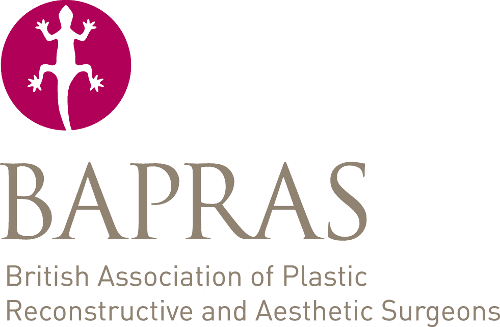Macrotia Surgery / Ear Reduction
What is Macrotia?
Macrotia is excessive enlargement of the external ear. This refers to the vertical height and width of the ear. The average vertical height for a female ear is 5.9cm and for a male ear 6.2 cm. Usually when the vertical height exceeds 6.5 cm the ear can appear enlarged and out of proportion to the head. Age, sex, height and head size all play a part in how large the ear may appear. Excessively large ears can be a significant cause of concern for many people as they can attract excessive attention and unbalance the harmony of the face.
In the majority of cases the enlargement is in the upper third of the ear as a result of a wide scapha. The scapha is the flattened area between the helical rim and the antihelix. This is the part of the ear that is most commonly reduced in ear reduction surgery. This gives more balance to the ear and better harmony to the face.
Macrotia Causes and Symptoms
There are several pathological conditions that are associated with increased ear size but these are very rare. Age is also a contributing factor with ear circumference increasing marginally as people get older as well as elongation in the earlobes. However, nearly all cases presenting for aesthetic reasons have no specific cause with developmental and genetic factors being primarily responsible. There are no specific symptoms attributed to an increase in ear size. Patients may complain ears are sensitive and uncomfortable wearing certain type of helmets. The main problem is that Macrotia can have a negative effect on confidence and social interaction.
Am I suitable for Macrotia Reduction Surgery?
Nearly all macrotia ears can be reduced in size. Some limiting factors include previous surgery and scarring that can compromise the blood supply to the ear. In such cases ear reduction surgery can still be undertaken by a surgeon who is experienced in ear surgery. Ear reduction in smokers is associated with increased risks in wound healing and it is recommended to stop smoking for 6 weeks before ear reduction surgery.
How is Macrotia Surgery performed?
Different parts of the ear can be enlarged disproportionally and surgical treatment is individually tailored. Macrotia surgery is usually performed by removing a crescent of skin and cartilage from the scapha on the front of the ear. Skin on the back of the ear is not removed. The width of the crescent will dictate how much the ear is reduced. The outer arc of the crescent is then advanced towards the inner arc to close the gap. This usually necessitates removal of a small segment of the helical rim. The resulting scar is just within the helical rim a small horizontal scar on the rim itself. These scars heal extremely well that they are almost invisible after a few months.
The surgery can be performed under local anaesthetic and all the stitches are dissolvable. A bandage is worn overnight but can be removed after 24 hours.
Is Ear Reduction Safe?
Ear reduction surgery is a very safe operation when performed by an ear specialist as it requires experience and appreciation in how the ear alters its shape during the reduction process. When the operation is performed with focus on precision, meticulous technique and appreciation of ear skin blood supply complications are negligible. In addition, by performing the procedure under local anaesthetic risks from a general anaesthetic, although extremely rare, are also eliminated.
Ear Reduction Surgery Risks
Complications that can occur following ear reduction are rare and minor. There is a minor degree of swelling which usually resolves by the second week. In the first 24 hours minor bleeding from the wound may occur which is of no consequence. Infection risk is very small (1%) and responds well to antibiotics. Scars can be slightly red in first 3 months but always settle down.
There is an increase risk complication in smokers and it is recommended to stop smoking for 6 weeks before surgery as nicotine constricts the blood vessels decreasing the blood supply.

Before and After
The image to the left shows an example of the before and after of the Ear Reduction surgery.
More images are available in the click at the bottom of the page.
What happens after ear reduction surgery?
At the completion of the operation antibiotic ointment is applied to the wound and soft cotton wool placed over the stitches. A bandage is then applied which will hold the dressing in place over for the first night. The bandage is removed the next day and a very soft head band is provided to cover and protect the ears. There is minor discomfort following the operation which is well controlled with paracetamol / ibuprofen. Most gentle daily activities can be resumed the next day. It is best to delay vigorous physical activities for 2-3 weeks until the wounds have completely healed. Following wound healing the ears may remain slightly tender to touch for a few months as the scar remodels. After 6 months the scar is almost invisible.
Will Surgery affect my hearing?
Ear reduction surgery does not interfere with the hearing mechanism of the ear.
When will I see the results of ear reduction surgery?
You will be able to see the results of ear reduction surgery immediately in the operating theatre at the completion of the operation before a bandage is applied. The bandage can be removed the next day and the result of the reduction will visible but at this stage there will be some cotton wool over the stitches in the scapha and it is important to appreciate that at this stage there is some swelling. The swelling will reduce over 2 weeks and the stitches will fall out on the third week.
Contact Walid Sabbagh
To arrange an appointment or for any other enquiries, please call or use the form.
Mob: +44 (0)7761 792 835
Tel: +44 (0)203 0020124



